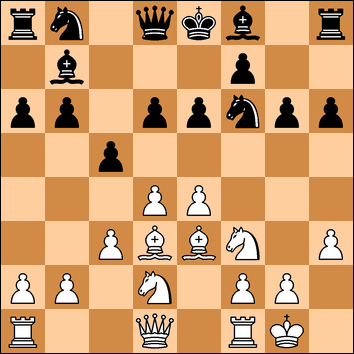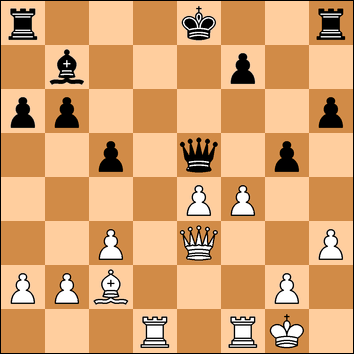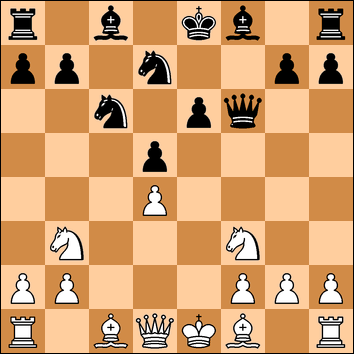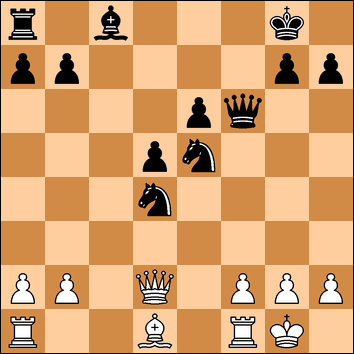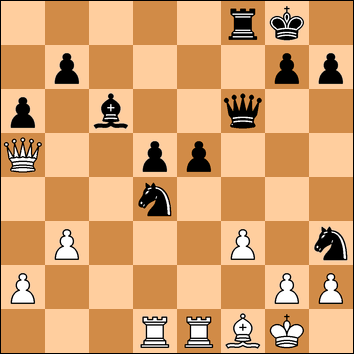Thursday 26 May 2016
White: A. Gillard (106) - Black: K. Nevols (132)
The last game of the season. I needed to win to be sure of a third place in the championship - which would not be bad for my debut season after 20 years away.
1. e4 d5
Back to the ever reliable Scandinavian Defence. The grades are misleading here - my opponent is stronger than it appears - and I had held a fortunate draw earlier in the season - so I went for my standard safe defence against superior players.
2. exd5 Qxd5
3. Nc3 Qa5
4. d4 Nf6
5. Bd2 c6
My regular response to an early Bd2. 5. .. Qb6 could be worth considering. After 6. Nf3 Black can't take the pawn because of 6. ... Qxb2 7. Rb1 Qa3 8. Nb5 but 6. .. Bg4 and Black is already under some pressure.
6. Nf3 Bf5
Many players prefer 6. .. Bg4 but I prefer this position of the bishop.
7. Ne4
A discovered attack which is perfectly safe for Black.
7. ... Qc7
8. Nxf6+ exf6
9. Bc4 Be7
White has an edge because Black is behind in development. I think 10. O-O might be best here but White decides to go after the bishop.
10. Nh4 Bg6
Now if 11. Qg4 Black can't castle because of 11. .. O-O 12. Nxg6 hxg6 13. Qxg6. So 11. .. Qd7 would be a sound defensive move.
11. Nxg6 hxg6
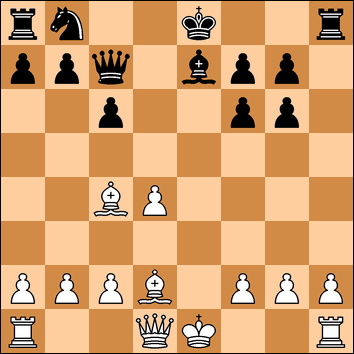
The square of pawns looks odd but I have played it before and it is a great defensive barrier. Not only that but now the h8 rook can develop down the h-file - so it may have been better for White to wait for Black to castle before going after the bishop.
12. g3
To defend the h2 pawn, although 12. h3 might have been more accurate.
12. ... Nd7
13. Qe2
White prepares to castle queenside and also stops Black from castling because of the loose bishop. I gave some thought to 13. .. Nb6 here with 14. Bb3 a5 but my king safety remained a concern so I came up with a move which I thought was quite novel.
13. ... Kf8!?
As I have the h-file to develop my rook then castling is not necessary. White has the advantage in space and the two bishops, and the computer rates his position as best by two thirds of a pawn. Having said that, I would say that Black's position is not too bad - there are (yet) no obvious weaknesses.
14. O-O-O
Now I wanted to go on the counter attack and came back to the idea of Nb6 or even b5.I looked at 14. .. b5 15. Bb3 a5 16. a4 or 15. Bd3 a5 but instinct told me that this was wrong. Instead I decided to continue to develop and advance in the centre.
14. .. Nb6
15. Bb3 Rh5
A great square for the rook while I think about what to do with it next.
16. f4
This surprised me. It blocks in the dark squared bishop. I now try to sort out my centre while also aiming to block the diagonal of the other bishop.
16. ... Nd5
17. Rhe1 Qd7
18. Kb1 Re8
19. Qg2 Nb4
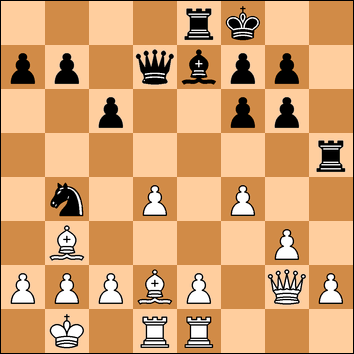
White has 32 minutes for 16 moves. Black has 27 minutes. I was now becoming concerned over White's pressure in the centre and seemed to be running out of things to do. I now expected 20. c3
20. Be3 Bd8
Making use of the opportunity offered by the closure of the e-file to redeploy the bishop.
21. Re2 Bb6
22. Rde1 Nd5
Now White needs to play 23. Bg1 Rxe2 24. Rxe2. Maybe Black can then try 24. .. g5.
23. Qf2?
However this drops a pawn.
23. .. Nxe3
24. Rxe3 Rxe3
25. Qxe3
if 25. Rxe3 then simply Bxd4.
25. ... Rxh2
26. c3 Bc7
Now back to the g5 plan. With a 4 v 2 (sort of) majority, it was time to advance on that side of the board.
27. Ka1 Rh3
28. Qf3 g5!
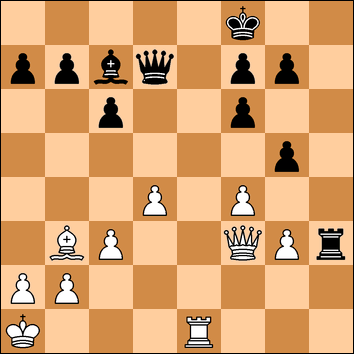
I was very pleased to find this move. Now if 29. Qg2 Black should only play 29. ... gxf4 if he is prepared to sacrifice his queen as White has the dazzling 30. Be6!?! Then 30. .. Qxe6 (30. ... fxe6? 31. Qxh3) 31. Rxe6 Rxg3 32. Qh2 fxe6 leaving Black with a rook, knight and three pawns against a queen. The computer says that Black should win this but I cannot say it is an ending I would like to pay.
29. fxg5 Rxg3
30. Qf1 Rxg5
Another pawn picked up.
31. Qc4 Rh5
I was very concerned about a white rook arriving on the h-file so decided to get there first.
32. Qe2 Rh2
33. Qc4 b5?
Poor. An unnecessary weakening of the queenside. Why not just get on with it with f5?
34. Qd3 f5
35. Bc2 f4
At last, Black finds the correct plan and, for the first time, I felt I had serious winning chances.
36. Qf3!!
Wow! White sacrifices a bishop to get the h-file. This is an amazingly imaginative move.
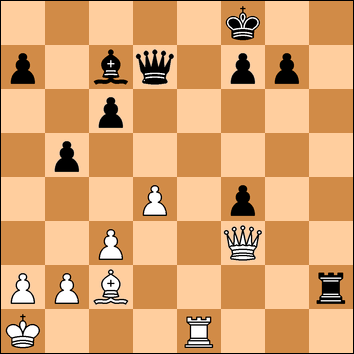
The line I saw was 36. ... Rxc2 37. Qh5 Kg8 38. Rh1 and this is looking nasty.
My subsequent analysis reveals:
(a) 38. ... f6 39. Qh7+ picks up the rook on c2.
(b) 38 ... Kf8 then 39. Qh8+ Ke7 40. Re1+ Kf6 41. Qh4+ g5 (if Kf5 then Qh3+ wins the queen - if Kg6 then Rg1+ Kf5; Qh3+) 42. Qh6+ Kf5 - and either 43. Qh7+ or 43. Qh3+ g4 44. Qd3+ also picks up the rook.
(c) Finally there is 38. ... f5 39. Qh7+ and:
(c1) either Kf7 40. Rg1 or
(c2) 39. .. Kf8 40. 40. Qh8+ Kf7 41. Rg1 Kf6 42. Qh4+ Ke6 43. Re1+ Kd5 44. Qh1+ Kd6 and White can now bully the rook with 45. Kb1!! Rf2 (45. .. Rd2 46. Qh4! Kd5 47. Qh1+ Kd6 48. Qh4 and a draw) 46. Qg1 Rd2 (46. .. Rf3 47. Qg6+ Kd5 48. Qg2) 47. Kc1 Rd3 48. Qf1 Rg3/e3 49. Qxf4+.
So the bishop sacrifice is perfectly sound. If White follows through correctly, he has very good chances of a draw or even a win.
I don't know how much of the above my opponent saw, and I certainly didn't see any of it, but, with my clock ticking, my instincts told me that to take the bishop would be a mistake. I am winning anyway so why take risks?
36. ... Rh3!
37. Qf1 g5
Just push pawns and see what happens.
38. Be4 g4
39. a3 f5
40. Bg2 Rh2
41. Qg1
This loses a piece but then 41. Bh1 f3 is not much fun either.
41. ... f3
42. Bxf3 gxf3
43. Qg6
Now I just need to guard against any perpetuals or swindles and it should be a home run.
43. ....... f2
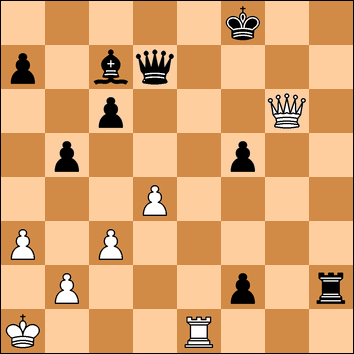
44. Qf6+ Qf7
45. Re8+
An interesting try but the position is lost.
45. .... Kxe8
46. Qxc6+ Kf8
Everything is guarded and White now resigned. A fascinating and interesting game.
